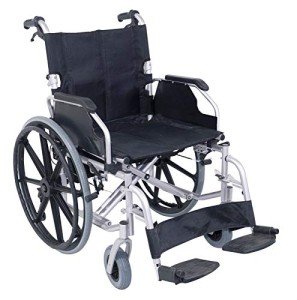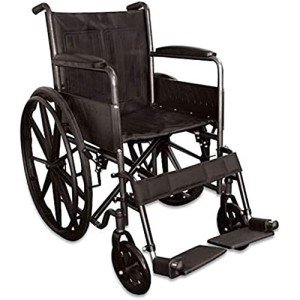Guide To Bariatric Living Aids: The Intermediate Guide In Bariatric Li…
페이지 정보

본문
 bariatric heavy duty transport wheelchair Living Aids
bariatric heavy duty transport wheelchair Living Aidsbariatric Living aids (https://yogicentral.science/wiki/What_Is_Bariatric_Wheelchair_Weight_Limit_And_How_To_Use_What_Is_Bariatric_Wheelchair_Weight_Limit_And_How_To_Use) are specialised products created to assist bigger individuals maintain mobility. They include a range of walking frames, rollators, canes and crutches.
It is recommended that the exact same brand/type of bariatric equipment be readily available for usage across units/programs to permit familiarity and decrease delays in patient care.
Walking Aids
Walking aids are equipment that are recommended by your physio therapist to keep mobility and self-reliance when you can not totally bear weight on one or both of your legs due to injury, surgery or discomfort. A physio therapist will evaluate you and select and fit the most appropriate strolling aid for your requirements considering your height, weight, healthcare plan and danger aspects.
There is a large variety of strolling aids from an easy single point walking stick to more complicated rollators and bariatric mobility aids forearm walkers. All of these aids can be personalized with different handles, bases (e.g. quad sticks, larger bases), adaptations and functions to suit your specific requirements.
A methodical evaluation of research studies analyzing the impacts of strolling aids on activity and participation was conducted utilizing medical, musculoskeletal and occupational therapy databases. An overall of thirteen studies were included and examined according to their methodological quality. The results showed that strolling aids were reliable in allowing individuals with handicaps to continue their usual activities, consisting of work and leisure, by decreasing the amount of assistance they required to do this.
However, it is essential to remember that not everyone will accept making use of a walking help. Some might feel a sense of loss of independence or stress that they will look frail. It is important that therapists deal with these concerns and highlight the security and functional benefits of the walking aid.
In addition, this research study found that self-reported strolling constraints of a couple of blocks or an objectively defined mobility deficit were related to fewer steps daily and fewer high cadence minutes. These outcomes reinforce the importance of dealing with discomfort and other health-related barriers to walking, especially in midlife and older adults. The most common reasons for these walking restrictions were BMI, older age, lower income and higher bodily pain. These findings suggest that a multidisciplinary technique to counseling for increased walking can have favorable influence on both functional outcomes and lifestyle.
Rollators
A bariatric wheelchair 22 inch rollator offers extra assistance for individuals who might need a little bit more stability while strolling or have issues with balance. These four-wheeled mobility aids are generally designed to hold patients weighing as much as 500 pounds or more. They include a strong frame made with sturdy materials for sturdiness and are able to withstand the additional weight that includes bariatric wheelchair uk clients.
 If you have a condition such as arthritis, several sclerosis, or Parkinson's illness, a rollator can help in reducing the strain on your joints and muscles while strolling. In fact, a research study of patients with Parkinson's disease discovered that those who utilized a rollator experienced lower falls and injuries than those who did not use one. This is due to the fact that using a rollator helps in reducing the amount of energy it requires to walk, allowing you to take in more oxygen and decrease discomfort in your legs and hips.
If you have a condition such as arthritis, several sclerosis, or Parkinson's illness, a rollator can help in reducing the strain on your joints and muscles while strolling. In fact, a research study of patients with Parkinson's disease discovered that those who utilized a rollator experienced lower falls and injuries than those who did not use one. This is due to the fact that using a rollator helps in reducing the amount of energy it requires to walk, allowing you to take in more oxygen and decrease discomfort in your legs and hips.Unlike basic rollators, a bariatric design has a seat and a crossbar for back assistance to offer more stability while sitting. Many bariatric designs are also created with locking brakes to guarantee security while seated, and they have durable wheels for mobility on numerous kinds of surface areas. Some are even geared up with baskets and notches to make it much easier to bring products.
The key to selecting the ideal bariatric rollator for your requirements is understanding the weight capacity. This is very important not just for security, Bariatric living aids but also to prevent the equipment from becoming harmed or used down due to excess weight. Requirement rollators are frequently evaluated to support approximately 250-350 pounds, however you must look for a model with a higher weight capacity if you need it.
It's essential to keep in mind that a rollator is not indicated for riding, and you should never ever rest on it for extended periods of time. It can become unsteady and trigger you to fall, so you should constantly keep a chair, walking stick, or crutches nearby in case you require them. It's also best to keep a buddy or member of the family with you when utilizing a rollator to make certain they can help if required.
Canes
The most basic of all strolling aids, the walking cane is used by patients who require aid with balance and stability. It's a great concept to get a physical therapist or physician's recommendation before acquiring a cane considering that a walking cane not matched for your needs might cause added stress and stress on your body. You'll likewise require to know how to utilize the walking cane properly to avoid new injuries and re-injury.
The most common type of walking cane is the single-point cane. It has an idea that reaches the ground and a manage at the top. Normally, you ought to hold the walking cane in the hand opposite the leg that's injured or weakest. It's likewise crucial to look forward when you stroll rather of down at your feet. Your elbow must be slightly bent when you hold the walking stick's manage.
If you need a walking cane to climb stairs, make sure the walking stick is kept in the hand that's opposite your wounded leg which you take each action first with your injured leg. After the foot is down, then you can lift your other upper hand to finish the step. This prevents you from putting too much weight on your hurt leg and it helps to keep you balanced.
Another choice is a center balance walking cane, which has one point of contact with the flooring and a flat and bigger deal with. This walking cane is easy to grip and permits you to place more pressure on it when standing up or sitting down. This is the best option if you're transitioning far from utilizing a walker.
If you desire to purchase a cane for bariatric living, your medical professional or physical therapist will be able to suggest a brand name that's ranked for your specific weight. You can also acquire walking canes at numerous drug stores and medical supply stores. You can usually find walking canes with various deal with types, including a rubber pointer for additional traction on most surface areas. It's an excellent concept to check the tip on your walking stick daily and replace it when needed. If the pointer ends up being worn or stiff, you can find replacement pointers at many drug stores and medical supply shops.
Crutches
Crutches are the most basic and most common type of strolling help. They are easy to learn to utilize and are reasonably affordable. Nevertheless, they can cause issues if not used effectively. Your medical professional will provide a pair of crutches and teach you how to use them safely. They are normally available from medical supply stores and can also be acquired nonprescription at some drug stores.
Using the right size crutches is very important. The top of the crutches need to be about two finger widths below your armpit. Make sure the hand grips are at hip level and that your elbows are a little bent when you hold them. You must never put any weight through the manages however just through your arms and hands. Leaning on your armpits with the crutches can hurt the shoulder joints and nerves and likewise tire you out faster than just utilizing your hands.
A physiotherapist is a crucial member of your health care team who will teach you how to use the crutches. You can discover one at your regional hospital, rehabilitation center or personal practice. They will guarantee the crutches are sized properly for you and show you how to properly utilize them.
You should always wear shoes with rubber or non-skid soles when using crutches. You must likewise check the tip or tips of your crutches daily and change them if they are worn. Keep the crutches away from water and prevent stepping on them in bathtubs, showers or sinks.
Stairs are one of the most difficult parts of utilizing crutches. You must stand at the top of the stairs and get your balance before moving. Then, move the crutches to meet your recovering leg and step down slowly. Remember to keep the handrail nearby for assistance and do not let your crutches slip.
It may spend some time to master utilizing crutches however they can increase your mobility and self-reliance while your injury heals. With persistence and cautious use, you ought to be able to go back to your normal routine with little problem.
- 이전글10 Things That Your Competitors Inform You About Cordless Power Tool Set 25.02.06
- 다음글The Greatest Sources Of Inspiration Of 2 Seater Fabric Sofa 25.02.06
댓글목록
등록된 댓글이 없습니다.

